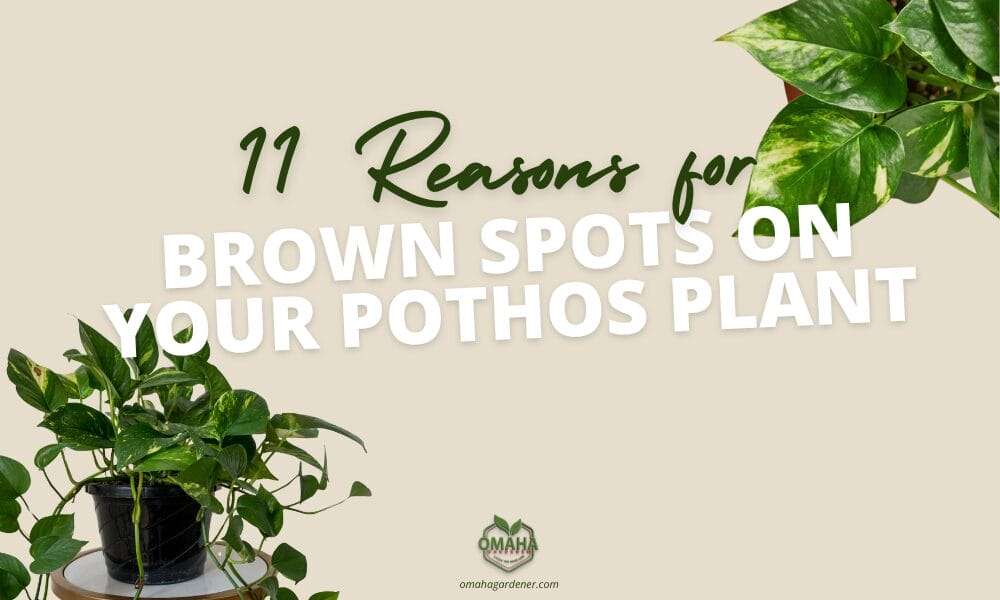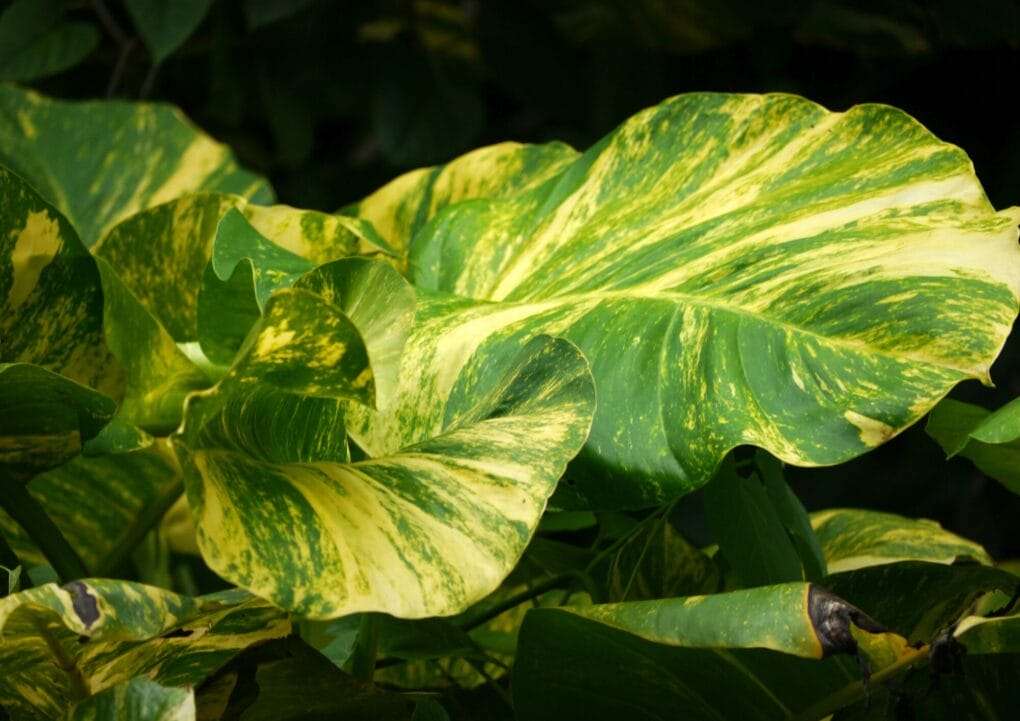
Pothos plants, renowned for their graceful hanging vines, can lose their visual allure when brown spots emerge, whether as blotches dispersed across the leaf centers or along the margins. This phenomenon prompts an intriguing question: what lies behind this browning, manifested in the form of discrete spots or expansive blotches?
The spectrum of culprits contributing to the browning of pothos leaves is diverse, encompassing factors such as overwatering, underwatering, the utilization of tap or hard water, overfertilization, suboptimal sunlight exposure, fluctuations in humidity, root rot, the insidious presence of bacterial wilt disease, and the stealthy invasion of scale bugs.
Maintaining an optimal balance in environmental conditions emerges as the critical imperative to forestall the development of these unsightly brown spots on your beloved pothos. Let us discuss each of them in detail.
Table of Contents
Overwatering
Browning Location: Primarily observed at leaf margins or sporadically as blotches at the center.
Giving your pothos too much water can cause some real problems! Picture this: when you water your plant too much, the soil gets really wet. But here's the catch—too much water means there's less room for something super important: oxygen. You know, the stuff we all need to breathe? Well, plants need it too!
Now, when water takes over and pushes out the oxygen, the roots of your pothos start struggling. They find it hard to grab onto the essential things they need—water and nutrients—to keep the plant healthy. It's like a traffic jam in the soil! This creates a double whammy for your plant: it's not getting enough oxygen, and the transportation system for nutrients is all messed up.
And guess what happens next? Your poor plant shows its distress by turning yellow and, eventually, getting those sad brown spots on its leaves. So, less water, happy plant! Keep it simple, and your pothos will thank you with lush, green leaves.
Pro Tip: Adopt a prudent watering regimen, emphasizing a once-a-week watering schedule to circumvent the potential oxygen shortage.
Underwatering
Browning Location: Predominantly affecting leaf margins or extending to the tips.
When your pothos soil gets super dry, it's like a roadblock for its growth! Imagine this: the soil is so parched that the poor plant can't stretch its roots and spread out comfortably. This dry spell makes it tough for the plant to grow big and strong.
Now, think about your own skin—when it gets too dry, it can feel tight and uncomfortable, right? Well, it's kind of the same for the leaves of your pothos. When the soil is too dry, the leaves start feeling brittle, like they're lacking that moisture they need to stay flexible and happy.
So, if you notice your pothos leaves starting to feel crispy and brown, it's like a signal from your plant saying, “Hey, I need a drink!” Adding a little water to the soil is like giving your pothos a refreshing gulp to help it thrive and keep those leaves nice and vibrant. Happy soil, happy pothos!
Pro Tip: Establish a fixed watering schedule to avoid prolonged drought periods.
High Sunlight Exposure
Browning Location: Notably affecting leaf margins and tips.
When your pothos gets too much direct sunlight, it's like spending too many hours under the blazing sun without sunscreen.
This excess sunlight can be a bit harsh on your plant's leaves, causing something akin to a sunburn—leaf burning! Now, think of your pothos as someone who loves a perfect day at the beach. To keep the vibes just right, it prefers temperatures between 70-90°F. It's like finding the ideal temperature for your comfort.
Pro Tip: Position plants in east-facing or west-facing windows to avoid direct sunlight exposure.
Low Sunlight Exposure
Browning Location: Initiating from the leaf surface's center.
Think of your pothos as a green superhero, and sunlight is its power source. Now, when this hero doesn't get enough sunshine, it's like losing its superpowers. The magic ingredient here is chlorophyll, the green stuff that makes plants, well, green.
Picture this: without sufficient sunlight, it's as if chlorophyll takes a nap, and the leaves start feeling a bit yellow. If this continues, it's like the hero losing the battle, and those yellow spots turn into brown patches.
Pro Tip: Relocate plants to well-lit areas or introduce LED grow lights to supplement lighting.
Low or High Relative Humidity
Browning Location: Predominantly at leaf margins.
If the air lacks moisture, it's like your pothos is in a desert without water. The leaves start feeling a bit thirsty, and if this goes on, they might get dehydrated and a bit sad. To keep your pothos feeling fresh and dewy, it's like setting up the perfect spa environment.
The humidity factor in the care regimen of pothos plants cannot be understated, particularly when it comes to the emergence of brown spots. In environments characterized by low humidity levels, pothos faces a challenge in maintaining adequate moisture, leading to leaf dehydration and, consequently, the formation of those undesirable brown spots.
To navigate this, plant enthusiasts should strive to create a balanced and moderately humid atmosphere, ensuring that the pothos receives the optimal moisture it requires to thrive and preventing the occurrence of brown spots. Maintain a humidity level between 50-70%, and your pothos will thank you with perky, hydrated leaves.
Pro Tip: Augment indoor humidity through the use of a humidifier, utilizing distilled water rather than essential oils.
On the contrary, high humidity can also pose challenges for pothos plants, particularly when it exceeds optimal levels. While pothos generally thrives in moderate humidity, excessively high humidity can lead to issues such as browning leaf tips. Adequate ventilation is crucial in humid environments to prevent poor air circulation around the plants. Consider placing a fan near the plants to improve air circulation. Monitoring humidity levels and making adjustments, such as using a dehumidifier if needed, can help create an environment conducive to the well-being of your pothos.
Over Fertilization
Browning Location: Discernible at leaf margins and tips.
Here's the scoop: this buildup of fertilizer turns into salts, and just like how too much salt isn't great for your favorite dish, it's not good for your pothos either. These extra salts in the soil start playing mischief with the plant's water and nutrient delivery system. Again, it's like a traffic jam, and the poor plant can't get the essential stuff it needs to stay healthy.
Pro Tip: Dilute fertilizers and explore organic options to circumvent salt accumulation.
Using Hard Water
Browning Location: Notably affecting leaf margins, tips, or forming blotches.
When you use hard water, it's like your plant is dealing with heavyweights, specifically calcium and magnesium. These minerals might be great for us, but for your pothos, it's a bit of a challenge.
Now, here's the plot twist: these minerals from hard water start stacking up in the soil. It's like they're building a barrier, making it tricky for water and air to navigate through the roots. Imagine your pothos roots doing a tough obstacle course, but with these mineral hurdles.
The best way to keep your plant's roots happy, consider using a gentler option like distilled water.
Pro Tip: Assess water hardness with a TDS meter and consider alternatives such as distilled water or a water softener.
Using Tap Water
Browning Location: Evident at leaf margins, tips, or as blotches.
Using tap water for your pothos may seem convenient, but it's a bit like giving it a drink that's not so great for its health. Tap water comes with some not-so-friendly guests—chlorides and fluorides. These are like unwelcome visitors in your pothos' party.
Now, here's the issue: these guests can stick around and turn into salts. It's a bit like having too much seasoning in your food. When these salts accumulate in the soil, they start causing trouble for your pothos roots. It's like they're putting up roadblocks, making it hard for the roots to do their job—helping the plant breathe, drink water, and grab nutrients.
Pro Tip: Gauge water quality with a TDS meter and opt for distilled water to mitigate salt buildup.
Scale Bug Infestation
Browning Location: Evident at leaf centers as distinct spots.
Meet the scale bugs, the tiny troublemakers in your pothos paradise. Despite their size, these sneaky bugs are experts at stealing nutrients, turning your plant's leaves into a canvas of yellow and brown. It's like they're hosting a nutrient feast without an invitation!
But fear not, because there's a hero in this story—neem oil. Picture it as your plant's shield against these tiny invaders. When you introduce neem oil, it's like sending these bugs an eviction notice. Neem oil disrupts their nutrient-stealing plans and helps your pothos reclaim its vibrant colors.
So, the next time you spot those sneaky scale bugs, bring in the neem oil cavalry.
Pro Tip: Vigilantly inspect and sanitize gardening tools to curb scale bug proliferation.
Bacterial Wilt Disease
Browning Location: Unfolding on the leaf surface, originating from the center.
Enter the bacterial wilt disease, a troublemaker led by Ralstonia solanacearum. It's like this microscopic villain wreaking havoc in your pothos world, turning its leaves into a palette of yellow and, eventually, brown. It's a bit like the plant catching a cold; it just can't shake off. To combat this, meticulous hygiene practices and disinfection are essential.
Pro Tip: Uphold appropriate watering, humidity, and air circulation to prevent bacterial wilt.
What effective measures can be taken to address bacterial leaf spot in pothos plants?
Bacterial leaf spot, a concern for pothos enthusiasts, demands a comprehensive approach for effective management. Utilizing a copper-based fungicide stands out as a potent solution, capable of curbing the progression of bacterial infections and minimizing the appearance of brown spots on pothos leaves. Simultaneously, strategic adjustments to the plant's environment, such as ensuring proper air circulation and adopting watering practices that minimize overhead moisture, become integral components of a holistic strategy to combat bacterial leaf spot and safeguard the overall health of the pothos plant.
Root Rot
Browning Location: Commencing at the leaf surface, emanating from the center.
Root rot, the sneaky troublemaker in your pothos underground world. When it strikes, it's like the roots are putting on a slimy disguise, disrupting the natural flow of water. It's a bit like turning your plant's roots into a waterlogged mess.
Now, here's the tough part: once root rot sets in, it's like a signal that your plant is in trouble. The slimy texture is a red alert, telling you it's time to take action. To rescue your pothos kingdom, the unfortunate but necessary step is to bid farewell to the affected plants.
Think of it as a superhero sacrificing one battle to win the war. Discarding the affected plants is like protecting the rest of your pothos squad from the clutches of root rot. It's a tough call, but it ensures the survival and health of the entire pothos kingdom.
Pro Tip: Mitigate root rot by reducing watering frequency to impede the spread of Phytophthora.
General Solution: Trimming Brown Leaves

As you've perused this article, you might have pondered, “Is it advisable to cut away brown leaves from the plant?” Indeed, trimming brown leaves on pothos plants proves to be a practical approach to optimize their growth process. When these leaves are pruned, the plant strategically reallocates its resources, encompassing water and sugars, to stimulate the development of fresh foliage. It's crucial to bear in mind to trim damaged leaves right above the node, allowing room for the emergence of new leaves.
Dealing with brown tips on pothos leaves requires a nuanced approach. Evaluate the watering routine, ensuring it is consistent and appropriate for the plant's needs. Consider the humidity levels; if they are too low, use methods like pebble trays or a humidifier to create a more humid environment. Trim away the brown-tipped portions with clean, sharp scissors, cutting at a slight angle for aesthetic appeal. Focus on providing an ideal balance of water, humidity, and light to promote overall plant health and prevent further occurrences of brown tips. Regularly assess and adjust care practices to meet the evolving needs of your pothos.
Additionally, it is imperative to discard all pruned brown pothos leaves. Refrain from integrating them into the compost, as they may carry bacteria or fungi. Introducing these microorganisms into the compost can result in infections spreading among the plants.
Are you just starting your indoor garden? If so, this article may help: Beginner's Guide To Indoor Gardening
FAQs (Brown Spots On Your Pothos)
How do spider mites and scale insects contribute to the development of brown spots on pothos leaves?
Spider mites and scale insects, both notorious for wreaking havoc on pothos foliage, play pivotal roles in the emergence of unsightly brown spots. These pests, like spider mites, engage in the sapping of sap, leaving behind minuscule yet noticeable spots. Similarly, scale insects, with their waxy, brownish deposits, create a dual impact, compromising both the aesthetic and physiological aspects of pothos leaves. Combatting these intruders becomes crucial for preserving the plant's health and preventing the progression of brown spots, requiring targeted treatments such as neem oil or insecticidal soap.
What are the most common causes of brown spots on pothos leaves
Brown spots on pothos leaves can stem from various factors. Excess water, often from overwatering or poor drainage, can lead to root issues and subsequent browning. Inadequate humidity or excessively dry soil may also contribute to brown spots. Direct exposure to extreme temperatures or too much sunlight can result in leaf burning and browning. Addressing these issues involves a holistic approach, including adjusting watering practices, maintaining optimal humidity levels, ensuring appropriate lighting conditions, and protecting the plant from temperature extremes. Regular monitoring and proactive care are key to identifying and mitigating the diverse causes of brown spots on pothos leaves.
How can a pest infestation of scale insects be efficiently handled in pothos plants?
Dealing with a pest infestation, particularly involving scale insects in the pothos domain, necessitates a vigilant and targeted approach. Employing natural remedies like neem oil or insecticidal soap emerges as an efficient means of combatting these minuscule intruders. Thorough application of these treatments on affected areas ensures comprehensive coverage, effectively disrupting the life cycle of scale insects and mitigating the potential damage they inflict. Regular monitoring and consistent application of these treatments contribute significantly to the successful control and prevention of scale insect infestations, minimizing the risk of brown spots on pothos leaves.
What are the underlying problems associated with yellow leaves on pothos, and how can they be effectively resolved?
Yellow leaves on pothos serve as visible indicators of underlying issues within the plant's care regimen. Problems such as incorrect watering practices, overwatering, or inadequate exposure to light can manifest in the form of yellowing. Addressing these issues requires a tailored approach—adjusting the watering frequency, ensuring proper drainage with drainage holes, and providing sufficient bright indirect light. By understanding and addressing these specific concerns, plant enthusiasts can not only resolve the yellowing issue but also prevent further discoloration and promote the overall well-being of the pothos plant.
How do I manage black spots on my pothos leaves?
Managing black spots on pothos leaves necessitates a comprehensive understanding of the underlying cause, which can stem from either fungal disease or bacterial issues. Begin by closely examining the affected leaves to determine the nature of the problem. For fungal-related black spots, adjust the plant's environment to discourage fungal growth—improve air circulation and avoid overwatering. In the case of bacterial issues, follow the protocol for bacterial infection management, including isolation, trimming, and treatment. Tailor your approach based on the specific cause to effectively manage and prevent the recurrence of black spots.
Conclusion
In the world of caring for pothos plants, we've learned how different factors can affect their health and vibrant greenery. From getting the watering balance just right to managing sunlight exposure and keeping an eye out for tiny troublemakers like scale bugs, it's been quite a journey.
Think of it like a dance – each step, from giving them enough sunlight to using the right water, contributes to a happy pothos. We've explored how hard water, over-fertilizing, and even microscopic bacteria can cause issues. It's like understanding the language of our plants.
So, the bottom line is that caring for pothos is a bit like being a plant detective. You watch for signs, adjust their environment, and ensure they have everything. Ultimately, it's not just about keeping leaves green; it's about creating a little green haven where our pothos plants can thrive and display their magnificent gold and green leaves!



